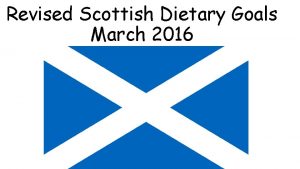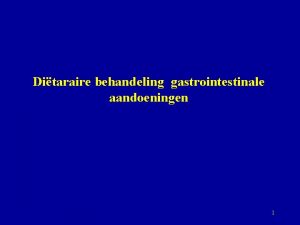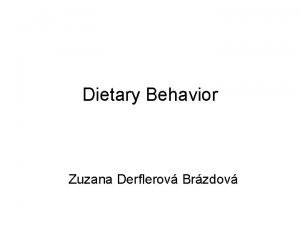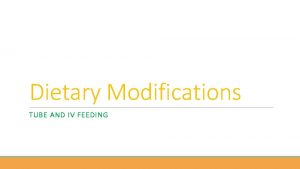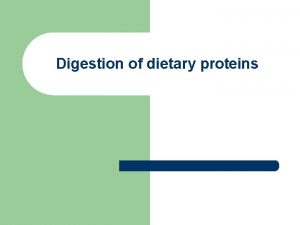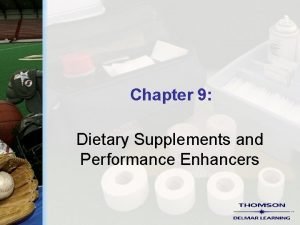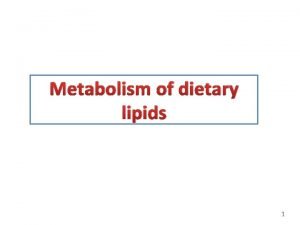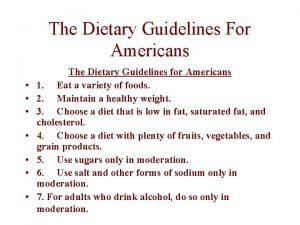Revised Scottish Dietary Goals March 2016 Scottish Dietary












- Slides: 12

Revised Scottish Dietary Goals March 2016

Scottish Dietary Goal: Consume less calories Specific advice: • Average energy density of the diet to be lowered to 125 kcal/100 g. • A reduction in calorie intake by 120 kcal/person/day. How can we achieve this? by reducing intake of high fat and/or sugary products and by replacing with starchy carbohydrates (e. g. bread, pasta, rice and potatoes, fruits and vegetables).

Scottish Dietary Goal: Consume more fruit and vegetables Specific advice: Average intake of a variety of fruit and vegetables to reach at least 5 portions person per day (> 400 g per day). How can we achieve this? By eating fruit as snacks, adding fruit to cereal, adding salad to sandwiches and by eating soup or drinking homemade smoothies.

Scottish Dietary Goal: Consume more oily fish Specific advice: Oil rich fish consumption to increase to one portion person (140 g) per week. How can we achieve this? By eating oily fish such as salmon and tuna or mackerel with salads or sandwiches for lunch and making meals such as fish pie or fish curry for dinner.

Scottish Dietary Goal: Consume less red meat Specific advice: • • Average intake of red and processed meat to be pegged at around 70 g person per day. Average intake of the highest consumers of red and processed meat (90 g person per day) not to increase. How can we achieve this? By varying our meals with a variety of poultry or fish or vegetables only, to provide a varied, balanced diet.

Scottish Dietary Goal: Consume less fat Specific advice: • Average intake of total fat to reduce to no more than 35% food energy. • Average intake in saturated fat to reduce to no more than 11% food energy. • Average intake of trans fatty acids to remain below 1% food energy. How can we achieve this? By eating less takeaway foods and cutting the quantities of fatty foods we use in our cooking, opt for leaner / low fat options.

Scottish Dietary Goal: Consume less sugar Specific advice: Average intake of free sugars, not to exceed 5% of total energy in adults and children over 2 years. How can we achieve this? By eating less breakfast cereals & fruit juice with added sugar, honey & soft drinks & replacing them with fruit/vegetables & milk.

What are Free Sugars? Free sugars are all monosaccharides and disaccharides added to foods by the manufacturer, cook or consumer, plus sugars naturally present in honey, syrups and unsweetened fruit juices. Lactose when naturally present in milk and milk products is excluded.

Scottish Dietary Goal: Consume less salt Specific advice: Average intake of salt to reduce to 6 g per day. How can we achieve this? By eating less processed foods and salty snacks such as crisps and nuts and by adding less salt during (and after) cooking.

Scottish Dietary Goal: Consume more fibre Specific advice: An increase in average consumption of AOAC fibre for adults (16+) to 30 g/day. Dietary fibre intakes for children to increase in line with SACN How can we achieve this? recommendations. By eating fibre rich foods - wholemeal bread, pasta, rice, cereals, vegetables (particularly with the skin on) chickpeas, figs etc.

Fibre, what does this mean? • Dietary fibre as measured using AOAC methodology (the association of analytical communities). • It is recommended that the average population intake of dietary fibre for children aged 2 to 5 years should approximate 15 g/day, for children aged 5 to 11 years 20 g/day, for children aged 11 to 16 yeas 25 g/day and for adolescent aged 16 to 18 years about 30 g/day.

Scottish Dietary Goal: Maintain Total Carbohydrate Specific advice: Total carbohydrate to be maintained at an average population intake of approximately 50% of total dietary energy with no more than 5% total energy from free sugars. How can we achieve this? Opt for starchy carbohydrates (bread, potatoes, pasta) over sugary carbohydrates (sweets, pastries) as they keep you fuller for longer and prevent snacking.
 What are the scottish dietary goals
What are the scottish dietary goals Strategic goals tactical goals operational goals
Strategic goals tactical goals operational goals Strategic goals tactical goals operational goals
Strategic goals tactical goals operational goals March march dabrowski
March march dabrowski Joint commission national patient safety goals 2016
Joint commission national patient safety goals 2016 General goals and specific goals
General goals and specific goals Motivation in consumer behaviour
Motivation in consumer behaviour Nutraceutical formulation
Nutraceutical formulation Dietary habits questionnaire
Dietary habits questionnaire Vitamin k dietary sources
Vitamin k dietary sources Mealracker
Mealracker Dietary indiscretion
Dietary indiscretion Dietary manipulation in sport definition
Dietary manipulation in sport definition
